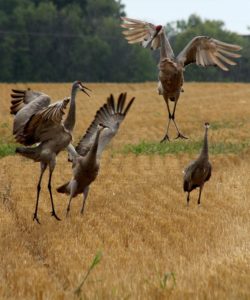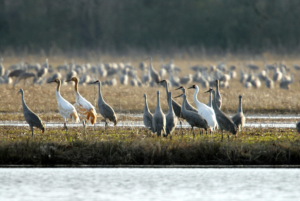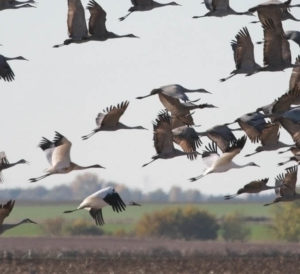 By Todd Schaller, WWA Vice President
By Todd Schaller, WWA Vice President
This article originally appeared in Wisconsin Waterfowl Association’s July, 2021 Newsletter edition.
Depending on your perspective or seat around the table when talking about a sustainable and ethical Sandhill Crane (SHC) hunting season in Wisconsin, the conversation is intertwined with challenges and opportunities. Based on the response to our first two articles in this series, those challenges and opportunities are being discussed now, even without a hunting season proposal on the table.
We touched on a few of these during the first two articles (Part I: Sandhill Crane Hunt in Wisconsin? and Part II: History & Biology). Article three of the series will take a dive deeper into this topic, but regrettably, still not hit on all of them due to space limitations.
Timeline and Steps
It is important to have a realistic understanding of the timeline for the process. As a migratory species, the US Fish and Wildlife Service (USFWS) has the final approval of a potential SHC season in Wisconsin. As previously mentioned, this authorization occurred in 2010 for the Mississippi Flyway States. From the flyway perspective, and with overall management for the Eastern Population of Sandhill Cranes, the USFWS must approve each state’s specific season structure (dates, harvest levels, permits etc.) in the context of the broader authorization that occurred in 2010.
So even if a Wisconsin Sandhill Crane hunting season proposal is legislatively approved and signed into law by the Governor, a hunting season would not happen immediately. It would take at least another two years for a state proposal to work its way through the WDNR and USFWS approval process.
Importantly, any season authorization from the USFWS would be considered experimental for a three-year period. Each state’s hunting season proposal would need to hit on seven key points.
- Estimates of population over at least a five-year period.
- Proposed season dates and any hunting zones.
- Proposed permit system – This would likely be a special permit situation. Wisconsin DNR has numerous wildlife harvest seasons that include special permits and harvest caps from which they can model a proposal to USFWS.
- Proposed method of data collection on harvest and hunter participation
- Proposed number of permits requested. USFWS has a formula for maximum harvest based upon five years of data supplied by the state.
- Proposed harvest numbers must also meet a formula for the entire Eastern Population.
- Educational tools to help hunters understand sandhill hunting and how to avoid harvest of non-target species, particularly whooping cranes.
The lengthy timeline and multiple steps required before a season could start can certainly be viewed as a challenge. This would be time and steps after a season is approved through the legislative process. No doubt some readers are disappointed it has already been eleven years since other state hunts have been authorized, without seeing any Wisconsin progress towards one.
The opportunity particularly lies within the seventh key point required in the plan, focusing on good conservation and being good stewards of the resource and species, which should be the ultimate goal of a sustainable and ethical SHC hunting season. While it takes time, public input and involvement in establishing the plan and associated regulations, it is an important step at the state level.
Breeding State
 As mentioned in article #2, Wisconsin is home to the largest breeding populations of the Eastern Population. Fall survey data indicates the Eastern Population of Sandhill Cranes reached the USFWS authorized hunt-able population level (30,000) in 1997 and has since grown to over 95,000. Current data analysis shows this to be about a 9.4% annual growth rate, an increase from the early 2000’s, which showed a 3.9% annual growth.
As mentioned in article #2, Wisconsin is home to the largest breeding populations of the Eastern Population. Fall survey data indicates the Eastern Population of Sandhill Cranes reached the USFWS authorized hunt-able population level (30,000) in 1997 and has since grown to over 95,000. Current data analysis shows this to be about a 9.4% annual growth rate, an increase from the early 2000’s, which showed a 3.9% annual growth.
This growth rate considers more than 2,000 SHC are removed annually from the population by abatement programs in which farmers with exceptional SHC crop damage are authorized to kill and destroy (burn or bury) these problem birds. It also considers hunting removal of nearly 2,000 SHC in 2020-21 in Tennessee, Kentucky and Alabama. It is significant that the population is still growing after accounting for these abatement programs in breeding states and managed hunting in three Eastern Population states.
Some SHC specialists believe Wisconsin’s prime breeding habitat may have reached its SHC carrying capacity, resulting in greater dispersal of SHC to other states/regions as sexually-mature-but-non-breeding cranes seek suitable habitat beyond Wisconsin. At the local level, I have seen this dispersal and potential shift with breeding pairs raising young on urban wetlands in the Dane County area.
This “saturation” of prime breeding habitat has given rise to a growing number of sexually mature, non-breeding SHC which often travel in groups. Although the exact number of these non-breeders is not clear, they are thought to be largely responsible for the increasing crop damage Wisconsin farmers are experiencing. It is not known what would cause these non-breeders to disperse to other locations where there might be suitable habitat. Meanwhile, here in Wisconsin, these involuntary celibates are a ready source of replacement breeders for losses to the breeding population.
Another unknown is the impact a hunting harvest might have on the breeding population long term. With limited experience hunting Eastern Population Sandhill Cranes, it is a legitimate question for which there is no current scientific study to answer. For this reason, the USFWS process authorizes a three-year “experimental” initial hunting opportunity if requested by states. This allows a “toe-in-the-water” approach to avoid a long-term negative impact. It highlights the focus on sound management and requires real-world evidence to allow a season, while also reducing the risks of that new season.
As managers of migratory species, both WDNR and USFWS are charged, and experienced, with managing the hunting impacts on breeding populations on all migratory game species. This is an explicit element of the USFWS required plans from states looking to establish a hunting season.
A key aspect of the Migratory Treaty Act (1918) and Flyway System is managing migratory species at the international level, not just within a particular state. Today, and into the future, the USFWS, along with its Mississippi Flyway partners, are managing the impacts of the harvest of Eastern Population Sandhill Cranes beyond each individual state border, and across the international flyway. In addition, it is looking at elements other than harvest, knowing populations are impacted by a variety of factors (predation, habitat, abatement, weather, etc.) Any harvest level established for Wisconsin would be part of the overall flyway management equation.
The legal hunting of Sandhill Cranes has been occurring for 50 years – the North America population exceeds 1,000,000 birds across six populations… from less than 100 SHC across North America 100 years ago. A Wisconsin season should be designed to avoid negatively impacting this conservation success story.
Whooping Cranes
 An item not touched on thus far is the reintroduction and recovery of the Whooping Crane, and how it would play into a Wisconsin SHC hunting season. As many are aware, Wisconsin is a summering location for Whooping Cranes with 83 documented in 2020.
An item not touched on thus far is the reintroduction and recovery of the Whooping Crane, and how it would play into a Wisconsin SHC hunting season. As many are aware, Wisconsin is a summering location for Whooping Cranes with 83 documented in 2020.
Like most recovery programs, it is a combination of habitat, regulation and the work of governmental agencies and conservation organizations making it a success. A key player with the Whooping Crane has been the International Crane Foundation.
This is clearly a challenge – any illegal or accidental killing of a whooping crane would have a significant impact on their population – and it could give a “black eye” to the hunting community. Although incidents of poaching, or illegal hunters shooting whoopers have occurred, there are no documented incidents in which mistaken whooping cranes have been killed by a legal hunter. Significant penalties (financial, etc.) are associated with the illegal killing of a whooper; most recently a fine and restitution of $85,000 was levied on a Louisiana poacher who shot two whoopers.
The opportunity around this topic is hunter education and specific species education, in addition to being one of the four hunting safety rules – “know you target and what is beyond”. In TN, KY and AL there is a required whooping crane identification test prior to being granted permission to hunt SHC. The WI whooping cranes may migrate through these states on their way to Florida. The USFWS and WDNR would likely require a similar education process in Wisconsin.
A bigger opportunity may be increased awareness and appreciation for the Whooping Crane recovery program. While many within the hunting community are aware of Whooping Cranes, if education became a bigger part of the conversation, and with a specific education program, it would no doubt increase this awareness.
A topic like reintroducing a hunting season on SHC will carry a significant amount of emotion on both sides of the question. Emotion can then create additional challenges and opportunities which we didn’t hit on with this article (see our partner article, “Seeking Common Ground”). From a WWA perspective, we are doing this educational series on Sandhills Cranes to better inform that conversation.
Going into this effort, WWA planned a four-part educational series on Sandhill Cranes and the issues in establishing a sustainable and ethical hunting season in Wisconsin. As we cross the halfway point, and with great feedback, WWA recognizes it is an interesting topic. I should say interesting and complex, so a four-part series isn’t enough space to hit on all the pieces to the puzzle. However, stay tuned for Part IV, focusing on key partners and partnerships and also Part V (and perhaps even a Part VI) in the upcoming newsletters.

